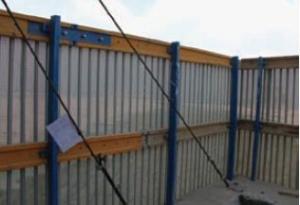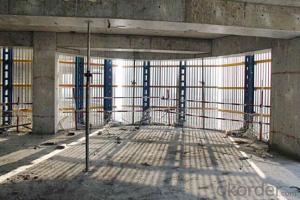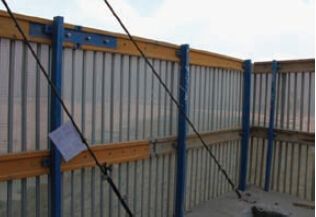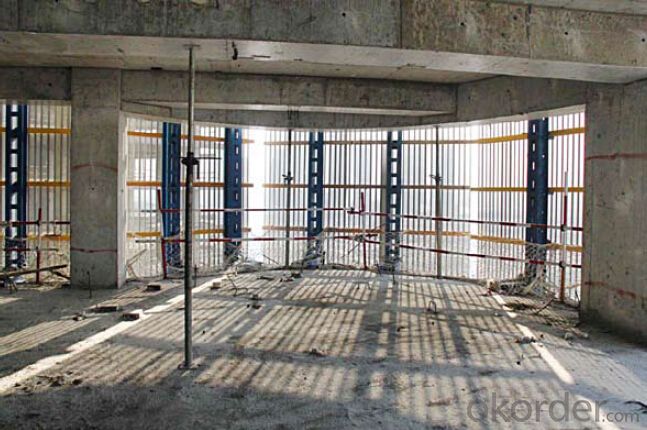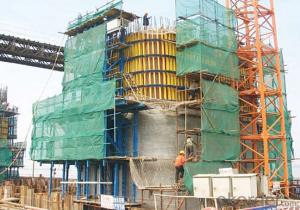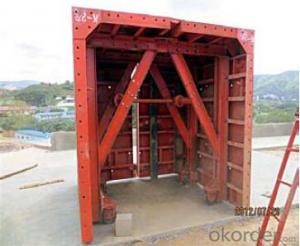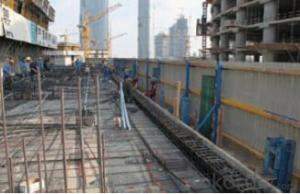Protection Platform for Formwork and Scaffolding build
- Loading Port:
- Tianjin
- Payment Terms:
- TT OR LC
- Min Order Qty:
- 50 m²
- Supply Capability:
- 1000 m²/month
OKorder Service Pledge
OKorder Financial Service
You Might Also Like
Protection Platform PP-50
A kind of new type construction protection system, applying operating platform and safer job
location for construction corps.
Characteristics:
◆ Easy and quick assembling.
◆ Lifted as a group, it is rapid and economic.
◆ Auto-climbing
◆ A safe and reliable anchor system
1. Composition
2. Assembly process of anchor system
(1) Embed V-climbing cone and anchor plate into the slab.
(2) Fix anchor shoe on the slab by tensile bolt.
(3) The fixed anchor shoe.
◆ High work efficiency with work platform and unload platform
◆ High light transmittance with the hollow block


- Q: How does steel formwork affect the concrete finish?
- Steel formwork can have a significant impact on the concrete finish. Firstly, steel formwork provides a smoother and more uniform surface compared to other types of formwork materials such as wood or plastic. This can result in a smoother and more aesthetically pleasing concrete finish. Additionally, steel formwork provides a higher level of dimensional accuracy and stability during the concrete pouring and curing process. This means that the concrete is less likely to shrink or warp, resulting in a more precise and even finish. Furthermore, steel formwork allows for tighter joints and fewer seams, which can minimize the occurrence of surface imperfections such as cracks or air pockets. This is particularly important for achieving a high-quality finish in architectural or decorative concrete applications. Moreover, steel formwork provides better resistance to moisture and chemicals, reducing the risk of staining or discoloration on the concrete surface. It also offers a higher level of durability, ensuring that the formwork remains intact throughout the entire concrete pouring process, resulting in a smoother and more consistent finish. In summary, the use of steel formwork positively affects the concrete finish by providing a smoother surface, better dimensional accuracy, fewer surface imperfections, improved resistance to moisture and chemicals, and enhanced durability.
- Q: What are the maintenance requirements for steel formwork?
- Regular cleaning and inspection are the key maintenance requirements for steel formwork. After each use, it is important to clean the formwork to remove any concrete residue, dirt, or debris. This can be achieved by using water and a mild detergent or, for tougher stains, a high-pressure washer can be employed. Additionally, it is crucial to inspect the formwork for signs of wear, damage, or corrosion. Prior to and after each use, a thorough examination should be conducted to ensure the structural integrity of the formwork. Any areas affected by rust or corrosion should be promptly treated by cleaning, sanding, and applying a rust inhibitor or paint to prevent further deterioration. Furthermore, it is necessary to regularly check the joints, connections, and fasteners of the formwork to ensure they are secure and functioning properly. Any loose or damaged components should be repaired or replaced as needed. Storage also plays a vital role in maintenance. To prevent rusting and corrosion, the formwork should be stored in a dry and well-ventilated area. It is recommended to stack the formwork correctly, leaving enough space between each piece to prevent deformation and promote air circulation. Lastly, it is essential to adhere to the manufacturer's instructions and recommendations for maintenance and care. This includes using the formwork within its designated load-bearing capacity, avoiding excessive impact or rough handling, and following any specific maintenance guidelines provided. By adhering to these maintenance requirements, the steel formwork can be maintained in optimal condition, ensuring its durability, reliability, and longevity for future construction projects.
- Q: How does steel formwork compare to other formwork materials in terms of durability?
- Steel formwork is highly regarded for its exceptional durability when compared to other formwork materials. Steel is known for its strength and resilience, making it a reliable choice for construction projects that require long-lasting formwork. Unlike materials like wood or plastic, steel formwork is resistant to warping, cracking, and rotting, ensuring its longevity and effectiveness over time. Additionally, steel formwork is highly resistant to the elements, including harsh weather conditions and exposure to chemicals. It can withstand heavy loads and pressures, making it suitable for projects that involve high-rise buildings, bridges, or other structures that require robust support during the construction process. Furthermore, steel formwork offers the advantage of being reusable. After a concrete pour, steel formwork can be easily dismantled, cleaned, and reassembled for future use. This reusability factor not only reduces construction waste but also proves to be cost-effective in the long run. However, it is important to note that steel formwork requires regular maintenance to prevent corrosion. Proper cleaning, rust removal, and application of protective coatings are necessary to ensure the formwork's durability and extend its lifespan. In summary, steel formwork outperforms other formwork materials in terms of durability due to its strength, resistance to various elements, and reusability. While it requires maintenance to prevent corrosion, steel formwork remains a preferred choice for construction projects that demand long-lasting and reliable formwork solutions.
- Q: Can steel formwork be customized for specific project requirements?
- Yes, steel formwork can be customized to meet specific project requirements. Steel formwork is highly versatile and can be fabricated to any shape, size, or design according to the project needs. It allows for flexibility in construction, ensuring that the formwork precisely fits the desired dimensions and complexities of the structure. Customization of steel formwork enables construction teams to optimize efficiency, accuracy, and safety during the concrete casting process.
- Q: Can steel formwork be used for both residential and commercial construction projects?
- Certainly, both residential and commercial construction projects can utilize steel formwork. This option is known for its versatility and durability in creating concrete structures, such as walls, columns, beams, and slabs. With its high load-bearing capacity, dimensional accuracy, and reusability, steel formwork proves to be suitable for various construction projects. In residential construction, it can be employed for building foundations, retaining walls, and even for crafting decorative elements. As for commercial projects, steel formwork is applicable in constructing office buildings, shopping malls, industrial facilities, and other large-scale structures. Moreover, steel formwork enables faster construction and enhances quality control, leading to time and cost savings for both residential and commercial projects.
- Q: What are the different types of formwork accessories used with steel formwork?
- There are several different types of formwork accessories that are commonly used with steel formwork. These accessories are designed to enhance the functionality and efficiency of the formwork system, and to ensure the safety of workers during the construction process. 1. Formwork clamps: These are used to securely fasten the formwork panels together, ensuring that they remain in position and do not move during the pouring of concrete. Formwork clamps are available in various sizes and designs to accommodate different formwork systems. 2. Formwork props: These are adjustable steel props that are used to support the formwork panels vertically. They provide stability and load-bearing capacity to the formwork system, making it safe for workers to operate on. 3. Formwork ties: These are used to hold the formwork panels firmly in place and prevent them from bulging or deflecting under the weight of the concrete. Formwork ties are typically made of steel and are available in different lengths and designs to suit the specific requirements of the construction project. 4. Formwork connectors: These are used to connect formwork panels together at corners or joints, ensuring a tight and secure fit. Formwork connectors come in various shapes and sizes, such as corner connectors, wedge connectors, and pin connectors. 5. Formwork brackets: These are used to support the formwork panels horizontally, providing additional stability and reinforcement. Formwork brackets are commonly used in beam and slab construction, where the formwork needs to be supported over a long span. 6. Formwork release agents: These are chemical substances that are applied to the formwork surface to prevent the adhesion of concrete. By using release agents, the formwork can be easily removed after the concrete has cured, allowing for efficient and smooth formwork removal. Overall, these formwork accessories play a critical role in ensuring the success of a steel formwork system. They provide the necessary support, stability, and reinforcement to the formwork panels, allowing for the efficient and safe construction of concrete structures.
- Q: Can steel formwork be used for circular columns?
- Yes, steel formwork can be used for circular columns. Steel formwork is a versatile and flexible option that can be easily adjusted to different shapes and sizes, including circular columns. Its strength and durability make it suitable for creating precise and stable concrete structures, even with complex geometries like circular columns.
- Q: How does steel formwork affect the overall vibration resistance of the structure?
- Steel formwork can significantly enhance the overall vibration resistance of a structure. Due to its strong and rigid nature, steel formwork provides excellent support and stability during the construction process, preventing any excessive movement or vibration. This helps in reducing the risk of structural damage or failure caused by vibration, ensuring the durability and safety of the building in the long run.
- Q: How does steel formwork affect the overall architectural aesthetics of the structure?
- Steel formwork can have a significant impact on the overall architectural aesthetics of a structure. The use of steel as a material for formwork can provide a sleek and modern appearance to the building. Its smooth and rigid surface allows for precise and clean lines, resulting in a more refined and elegant look. Steel formwork also offers great flexibility in terms of design possibilities. It can be easily shaped and molded into complex and intricate patterns, allowing architects to create unique and visually appealing structures. This versatility opens up a wide range of architectural possibilities, enabling the creation of buildings with distinct and eye-catching features. Furthermore, steel formwork provides a high level of structural stability, which enhances the overall aesthetics of the structure. The use of steel ensures that the formwork remains strong and sturdy, even under heavy loads, which is crucial for creating large and imposing architectural designs. The ability to use steel formwork in such constructions allows architects to achieve bold and impressive architectural forms that might not be possible with other materials. In addition to its visual impact, steel formwork also offers various practical advantages. It is a durable and long-lasting material that can withstand harsh weather conditions, making it suitable for both indoor and outdoor applications. Steel formwork is also highly resistant to fire, corrosion, and pests, further ensuring the longevity and integrity of the structure. Overall, steel formwork plays a crucial role in shaping the architectural aesthetics of a structure. Its smooth surface, flexibility in design, structural stability, and durability contribute to creating visually appealing and iconic buildings. By choosing steel formwork, architects can achieve both functional and aesthetic goals, resulting in structures that are not only beautiful but also reliable and long-lasting.
- Q: What are the main components of steel formwork?
- The main components of steel formwork are panels, stiffeners, and connecting brackets. Steel formwork panels are typically made of high-quality steel sheets that are rigid and durable. These panels come in various sizes and shapes, such as rectangular, square, or circular, depending on the required shape of the concrete structure. They are designed to withstand the pressure exerted by the concrete during pouring and curing. Stiffeners are used to reinforce the steel formwork panels and enhance their load-bearing capacity. They are usually welded or bolted onto the panels to provide additional strength and stability. Stiffeners are particularly important in large-scale projects or when dealing with heavy concrete loads. Connecting brackets play a vital role in assembling the steel formwork system. They are used to connect the formwork panels together and ensure proper alignment and stability. These brackets are typically made of steel and are designed to securely hold the formwork panels in place. They are easy to install and remove, allowing for efficient and convenient formwork assembly. Overall, steel formwork offers numerous advantages such as high strength, durability, and reusability. Its main components, panels, stiffeners, and connecting brackets, work together to create a robust and reliable system that can withstand the pressure of concrete pouring and provide a smooth and accurate surface finish.
Send your message to us
Protection Platform for Formwork and Scaffolding build
- Loading Port:
- Tianjin
- Payment Terms:
- TT OR LC
- Min Order Qty:
- 50 m²
- Supply Capability:
- 1000 m²/month
OKorder Service Pledge
OKorder Financial Service
Similar products
Hot products
Hot Searches
Related keywords
